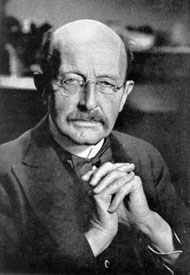| Max Planck  AKA Max Karl Ernst Ludwig Planck AKA Max Karl Ernst Ludwig Planck
Born: 23-Apr-1858
Birthplace: Kiel, Germany
Died: 4-Oct-1947
Location of death: Göttingen, Germany
Cause of death: unspecified
Remains: Buried, Göttingen City Cemetery, Göttingen, Germany
Gender: Male
Race or Ethnicity: White
Sexual orientation: Straight
Occupation: Physicist Nationality: Germany
Executive summary: Originator of quantum theory German physicist Max Planck proposed the quantum of action, now known as Planck's constant h, explaining the pattern of light intensity emitted from a black body at any given frequency. His work appeared in its earliest form in a 1900 paper titled Zur Theorie der Gesetzes der Energieverteilung im Normal-Spektrum (On The Theory of the Law of Energy Distribution in the Continuous Spectrum), which formed the baseline for a new field of physics, quantum mechanics. In oversimplified terms, Planck explained that energy is not a continuous, flowing entity, but is carried in tiny, discontinuous units, which he named quanta and described as "the pennies of the atomic world". Each quantum's energy is equal to the frequency of radiation multiplied by the universal constant which Planck defined.
His conclusion was in fundamental conflict with all previous physical theory, and was originally baffling or befuddling to other scientists, but provided a new understanding of the structure of light and radiation, phenomena that could not be adequately explained using classical Newtonian physics. Planck's work gained acceptance after Albert Einstein used Planck's constant h to determine the photoelectric effect, and Niels Bohr applied the principle to the atom (superseding Ernest Rutherford's atomic model).
He studied under Gustav Robert Kirchhoff and Hermann von Helmholtz, and his students included Walther Bothe, Gustav Hertz, and Max von Laue. His other work included research into chemical bonding, dispersion, kinetic theory, molecular rotational spectra, the optical properties of metals, and white light.
Planck remained loyal to the German government during its Nazi era, and Allied bombing of Berlin during World War II destroyed his home in the Berlin suburb of Grunewald, along with many of the papers documenting his work. His son Edwin was found guilty of involvement in Claus von Stauffenberg's "July plot" of 1944, an attempt to assassinate Adolf Hitler, for which the younger Planck was executed in 1945. After the war, Germany's leading scientific organization, the Kaiser Wilhelm Society for the Advancement of Science, was reorganized as the Max Planck Society. Father: Johann Julius Wilhelm Planck (law professor)
Mother: Emma Patzig Planck
Wife: Marie Merck Planck (b. 1861, m. 31-Mar-1887, d. 17-Oct-1909, two sons, two daughters)
Son: Erwin Planck (b. 1893, d. 1945 execution for Hitler assassination plot)
Son: Karl Planck (b. 1888, d. 1916 World War I)
Daughter: Margarete Planck (twin, b. 1889, d. 1917 in childbirth)
Daughter: Emma Planck (twin, b. 1889, d. 1919 in childbirth)
Wife: Marga von Hösslin Planck (b. 1882, m. 14-Mar-1911, d. 1948, one son)
Son: Herrmann Planck (b. 1911)
High School: Maximilian Gymnasium, Munich (1874)
University: University of Munich (attended 1874-77)
University: University of Berlin (attended 1877-78)
University: PhD Physics, University of Munich (1879)
Teacher: University of Munich (1880-85)
Professor: Theoretical Physics, University of Kiel (1885-88)
Professor: University of Berlin (1888-1927)
Nobel Prize for Physics 1918
Lorentz Medal 1927
Copley Medal 1929
Max Planck Medal 1929 (shared with Albert Einstein)
American Philosophical Society Foreign Member (1933)
German Physical Society Chairman (1905-08)
German Physical Society Chairman (1915-16)
Kaiser Wilhelm Society for the Advancement of Science President (1930-37)
Kaiser Wilhelm Society for the Advancement of Science President (1945-46)
Pontifical Academy of Sciences
Royal Prussian Academy of Sciences 1894
Royal Society Foreign Member (1926)
Royal Society of Edinburgh Foreign Member (1937)
German Ancestry
Lunar Crater Planck (57.9°S 136.8°E, 314 km. diameter)
Author of books:
Thermodynamik (Thermodynamics) (1897, non-fiction)
Theorie der Wärmestrahlung (Theory of Heat Radiation) (1906, non-fiction)
Vorträge und Erinnerungen (Lectures and Reminders) (1933, non-fiction)
Erinnerungen (Memories) (1946, memoir)
Max Planck in seinen Akademie-Ansprachen (Planck's Academic Speeches) (1948, non-fiction; posthumous)
Requires Flash 7+ and Javascript.
Do you know something we don't?
Submit a correction or make a comment about this profile
Copyright ©2019 Soylent Communications
|